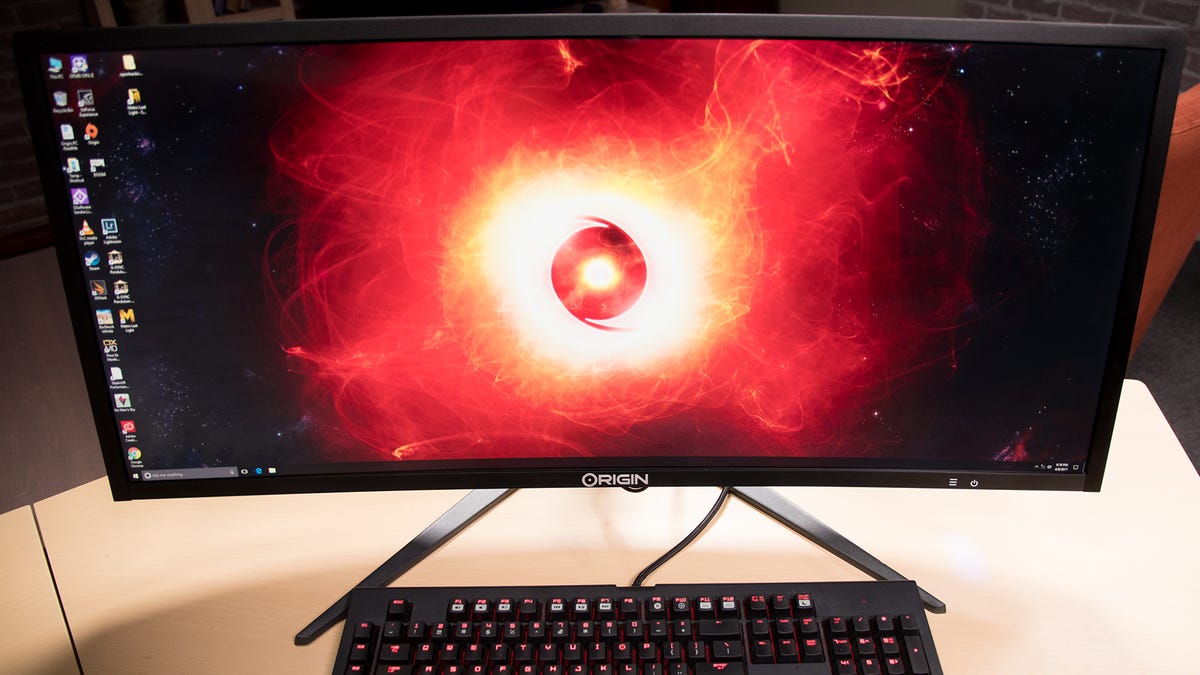
Clean and compact
One of the nice things about an all-in-one is the clean lines -- until you start attaching cables.
Wide screen
The 34-inch curved display does fill your field of vision pretty well.
Thin
The back of the display where the system components reside doesn't protrude much.
Power and OSD
The buttons for powering on the system and navigating the monitor's onscreen display feel loose and cheap given the cost of the system.
The underneath
What normally resides on the back of a desktop system -- the motherboard and graphics card connection panels -- is at the bottom of the display within a recess. That makes them really hard to get to. The motherboard is on the left, the graphics card outputs in the middle and the display inputs are on the right.
Motherboard connections
The motherboard does offer a ton of connectors, including two 10 Gb/sec USB 3.1 Gen 2 ports, two 3.1 USB ports earmarked for VR devices, plus two more USB ports -- which you'll note are blocked by the power cord.
Graphics card connectors
These, of course, will vary with your configuration.
Display inputs
There are two HDMI, one DisplayPort, and a Mini DisplayPort input for the monitor, as well as an audio connector. You can see how the graphics cabling runs across the bottom, and there's no way to connect the HDMI's without looping the cable around awkwardly like you see here.
Display inputs
It's not easy to get your fingers into the narrow area to plug in.
Deep recess
You can see how deep the recess is. When the system is standing up, you definitely can't see the connectors and it's hard to go by feel because there are so many.
Accessible connectors
On the back left of the display are USB 3.1, USB, headphone jack and mic input, as well as an SD card slot.
Venting
There are vents in the back behind all the components with fans. I wish it were transparent. As it is, the case doesn't support any kind of lighting effects, and you can see how much dust and fingerprints it attracts.
Inner glow
The Titan X proclaims itself from behind the vents.
Off angle
While you won't be sitting to the side while viewing, this gives you an idea of how the color and contrast shifts when you tilt the display up or down.
Top vents
Camera plugs in
The webcam plugs into a USB connector at the top of the system. It's a clever design -- you can use the top USB port for other devices as well.
However, that location is awfully high.
Webcam back
Cable management
Unlike a typical monitor stand, there's no way to manage all the cables coming out the bottom (this is just the keyboard and power; imagine it with five audio as well.
Side view, just because
On the inside
Everything's neatly laid out and accessible for easy replacement; getting inside requires the removal of about nine screws, not including the two for the stand. (I forgot to count.)
Motherboard
Here's the motherboard and cooling system.
The other side
You can see the motherboard, graphics card and storage here.

